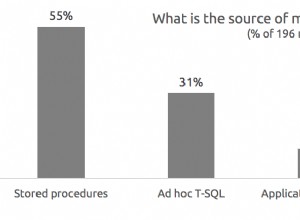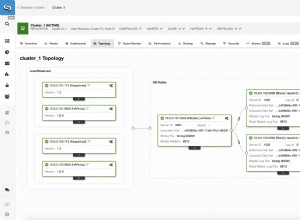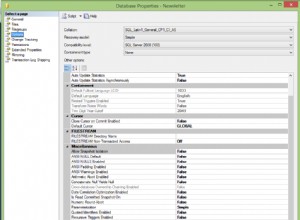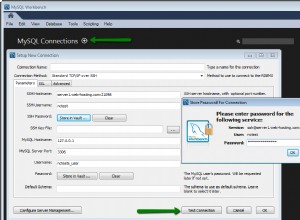Después de hacer algunos comentarios tal vez sarcásticos, este problema se quedó en mi cerebro toda la noche y finalmente se me ocurrió el siguiente enfoque basado en conjuntos. Creo que definitivamente califica como "elegante", pero también creo que califica como "un poco tonto". Usted hace la llamada.
Primero, configura algunas mesas:
-- For testing purposes
DROP TABLE Source
DROP TABLE Numbers
DROP TABLE Results
-- Add as many rows as need be processed--though note that you get N! (number of rows, factorial) results,
-- and that gets big fast. The Identity column must start at 1, or the algorithm will have to be adjusted.
-- Element could be more than char(1), though the algorithm would have to be adjusted again, and each element
-- must be the same length.
CREATE TABLE Source
(
SourceId int not null identity(1,1)
,Element char(1) not null
)
INSERT Source (Element) values ('A')
INSERT Source (Element) values ('B')
INSERT Source (Element) values ('C')
INSERT Source (Element) values ('D')
--INSERT Source (Element) values ('E')
--INSERT Source (Element) values ('F')
-- This is a standard Tally table (or "table of numbers")
-- It only needs to be as long as there are elements in table Source
CREATE TABLE Numbers (Number int not null)
INSERT Numbers (Number) values (1)
INSERT Numbers (Number) values (2)
INSERT Numbers (Number) values (3)
INSERT Numbers (Number) values (4)
INSERT Numbers (Number) values (5)
INSERT Numbers (Number) values (6)
INSERT Numbers (Number) values (7)
INSERT Numbers (Number) values (8)
INSERT Numbers (Number) values (9)
INSERT Numbers (Number) values (10)
-- Results are iteratively built here. This could be a temp table. An index on "Length" might make runs
-- faster for large sets. Combo must be at least as long as there are characters to be permuted.
CREATE TABLE Results
(
Combo varchar(10) not null
,Length int not null
)
Esta es la rutina:
SET NOCOUNT on
DECLARE
@Loop int
,@MaxLoop int
-- How many elements there are to process
SELECT @MaxLoop = max(SourceId)
from Source
-- Initialize first value
TRUNCATE TABLE Results
INSERT Results (Combo, Length)
select Element, 1
from Source
where SourceId = 1
SET @Loop = 2
-- Iterate to add each element after the first
WHILE @Loop <= @MaxLoop
BEGIN
-- See comments below. Note that the "distinct" remove duplicates, if a given value
-- is to be included more than once
INSERT Results (Combo, Length)
select distinct
left(re.Combo, @Loop - nm.Number)
+ so.Element
+ right(re.Combo, nm.Number - 1)
,@Loop
from Results re
inner join Numbers nm
on nm.Number <= @Loop
inner join Source so
on so.SourceId = @Loop
where re.Length = @Loop - 1
-- For performance, add this in if sets will be large
--DELETE Results
-- where Length <> @Loop
SET @Loop = @Loop + 1
END
-- Show results
SELECT *
from Results
where Length = @MaxLoop
order by Combo
La idea general es:al agregar un nuevo elemento (por ejemplo, "B") a cualquier cadena (por ejemplo, "A"), para capturar todas las permutaciones, agregaría B a todas las posiciones posibles (Ba, aB), lo que daría como resultado un nuevo conjunto de instrumentos de cuerda. Luego itere:agregue un nuevo elemento (C) a cada posición en una cadena (AB se convierte en Cab, aCb, abC), para todas las cadenas (Cba, bCa, baC), y tendrá el conjunto de permutaciones. Repita cada conjunto de resultados con el siguiente carácter hasta que se quede sin caracteres... o recursos. 10 elementos son 3,6 millones de permutaciones, aproximadamente 48 MB con el algoritmo anterior, y 14 elementos (únicos) alcanzarían los 87 mil millones de permutaciones y 1,163 terabytes.
Estoy seguro de que eventualmente podría encajar en un CTE, pero al final todo lo que sería es un bucle glorificado. La lógica es más clara de esta manera, y no puedo evitar pensar que el plan de ejecución de CTE sería una pesadilla.




